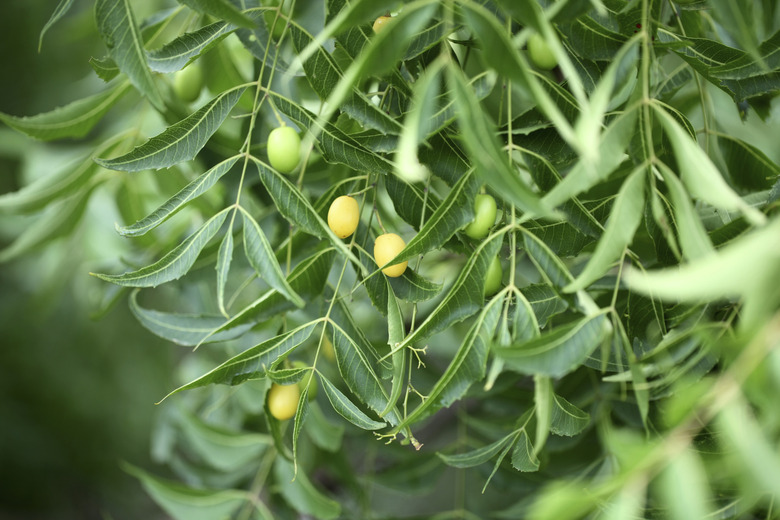The Characteristics Of Neem Trees
A gardener may try to love her ornamentals equally, but it's a tough order if you have a neem tree (Azadirachta indica). Revered in its native India, neem is one tough evergreen that offers leafy appeal, honey-scented blossoms, year-round shade and perhaps the key to a future of soft pesticides.
A Garden Centerpiece
Tall and leafy, the neem tree rises to 50 to 75 feet, has a dense crown and is hardy in U.S. Department of Agriculture plant hardiness zones 10 through 12. Its leaves, flowers and fruits each have particular highlights. The leaves — composed of eight to 18 leaflets — wave in the breeze like slender green fingers. The spring flowers dangle and sway in 10-inch-long panicles of snowy, sweet-smelling blossoms. Neem trees are said to be polygamous because one tree contains both male and bisexual flowers, that, in time, give way to olivelike drupes.
Simple and Undemanding
More than just a specimen plant, the neem tree provides a lot and demands only a little in a garden. It offers shade in a hot area with little rainfall and is extremely drought-resistant. It thrives in almost any well-draining soil, including deep sand, in sun or partial shade and in an outdoor garden or container indoors. Self-seeding so freely, however, it has become invasive in certain tropical and subtropical areas in Africa and Australia.
A Giving Tree
Even without its visible features, the neem tree would have plenty of fans because it helps prevent soil erosion. A neem tree improves soil fertility, neutralizes acidic soil and increases soil's water-holding capacity, according to the East African Network for Taxonomy. The tree's wood, so hard that it resists termites and borers, can be used for lumber. Perhaps most important, the oil from the leaves, termed neem oil, serves as a broad-spectrum botanical insecticide and fungicide. Neem oil is proving to be a nontoxic replacement for more dangerous and destructive pesticides.
Insect Repellent
The neem tree is virtually pest-free, and its foliage even repels locust swarms that decimate other plants in tropical regions. The tree accomplishes that feat by producing a chemical that protects its foliage against leaf-chewing insects. Neem foliage can ward off hundreds of pest species — repelling, rather than killing them — as well as fungi, bacteria and even viruses. The tree's dried foliage is beneficial, too; it is used to repel moths.
References
- Missouri Botanical Garden: Azadirachta Indica
- GrowOrganic.com: Neem — An Ancient Solution for Home and Garden
- University of Greenwich's Natural Resources Institute and Agroforestry Database: Azadirachta Indica
- National Academy Press: Neem — A Tree for Solving Global Problems
- East African Network for Taxonomy, BioNet Eafrinet: Azadirachta Indica (Neem)
